New Chromatography Columns and Accessories at Pittcon 2008: Part II
LCGC North America
This month's installment of "Column Watch" is the second part of a two-part series in which columnist Ron Majors examines the trends and highlights in columns and consumables at Pittcon 2008.
Pittcon 2008 — the 59th Pittsburgh Conference on Analytical Chemistry and Applied Spectroscopy — was held in New Orleans, Louisiana, March 1–7, 2008, the first time the Conference has returned there since the Katrina disaster. This year's event hosted more than 1150 instrument manufacturers and laboratory suppliers in more than 2500 booths. In addition to attending the exposition, the conferees listened to 1250 oral presentations, viewed more than 1000 posters, checked numerous company seminar rooms, or attended one of 114 short courses. The total attendance was around 19,500, down 10% from 2007.

Ronald E. Majors
Undoubtedly, Pittcon still remains the most important yearly international analytical exhibition, where companies introduce their latest instruments, instrument accessories, software, columns, sample preparation, and other consumable products. Because many past attendees have purchased one or more new products within three months after attending the show, most exhibitors attempt to maximize their booth traffic to meet as many potential customers as possible.
The purpose of this report is to provide information about many of the new separation consumables and accessory products that were displayed at Pittcon 2008. In some cases, products that were introduced during 2007 but after Pittcon 2007 (1,2) might be included for reasons of completeness. The information is based upon manufacturers' responses to a questionnaire mailed in December 2007. Because of space limitations and the fact that some manufacturers did not respond to the questionnaire, this report cannot be considered an exhaustive listing of all the new products that were introduced in New Orleans. However, over the years, these Pittcon introduction summaries have provided a good source of information that would be difficult for one individual to gather during the four days of the exhibition. In addition, the products introduced have shown definite correlations to current research, development, and application activity in the separation sciences.
As in previous years, columns and other products recommended by their manufacturers primarily for biomolecule separations or sample preparation are denoted in the tables with the designation BIO. Some of these products can be used for general high performance liquid chromatography (HPLC) separations as well, but their main emphasis is for biological samples. This year there was a marked reduction in products devoted strictly to bioapplications.
In this month's coverage, I will look at gas chromatography (GC) products, sample preparation products, hardware, and accessories and kits for chromatography and sample preparation.
Gas Chromatography
Although gas chromatography (GC) is considered to be a relatively mature separation technique, new GC columns continue to be introduced each year at Pittcon (Table I), 11 in all for this year. All GC columns were the wall-coated open tubular (WCOT) format with the exception of one packed column. An established company, Hamilton (Reno, Nevada), has entered a new market with a full line of GC capillary columns and a few packed columns while Agilent (Palo Alto, California) has introduced a new line of 0.18-mm i.d. capillary columns that provide high efficiency and high speed without requiring modification of the GC pressure system, which is sometimes required for 0.10-mm i.d. columns.

Table I: Gas chromatography columns
In recent years, there has been a GC trend in the introduction of ultralow-bleed WCOT stationary phases that allowed better detection limits, less baseline drift during temperature programmed separations, and improved compatibility with GC–mass spectrometry (MS) analyses. This year at Pittcon, many more columns are of the low-bleed, low-activity variety. Several are the common nonpolar and medium-polarity phases but based upon the incorporation of an arylene bridges into the polysiloxane backbone. This modification provides enhanced thermal stability and coating stability compared to regular methylpolysiloxane phases. In most cases, the upper temperature limits have been increased. Sometimes there are some subtle changes in selectivity with the arylene–polysiloxane phases.
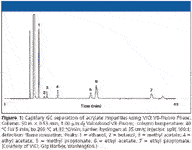
Figure 1
Applications-specific columns are always popular introductions at the exposition. New columns for biodiesel separations and reformulated spark ignition fuels (a two-column set) were displayed by Restek . A fluorophase that shows strong affinity for analytes containing lone pair electrons such as ketone, aldehydes, and unsaturated compounds was highlighted by VICI (Valco). Figure 1 shows a typical chromatogram of acrylate impurities on the ValcoBond VB-Fluoro capillary column. The low-bleed characteristics make this phase well suited to MS and electron capture detection, and its high thermal stability allows its use as a complementary column for high-temperature applications that commonly use low-polarity stationary phases.
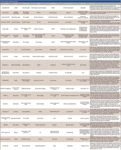
Table II: Sample preparation products
Sample Preparation Products
As indicated in Table II, Pittcon 2008 was another productive year with 20 new sample preparation products or families of products displayed. Not counted were sample preparation accessories (Table III), which will be covered later. Among the more popular introductions were products to deal with increasingly smaller amounts of available sample. Many solid-phase extraction (SPE) products ranging from cartridges, to pipette tips, to 96-well plates and spin tubes were among the formats introduced. Just about every mode of SPE (reversed phase, strong anion and cation exchange, normal phase, complexation, affinity, mixed mode, molecular imprinting, and hydrophilic interaction chromatography [HILIC]) was displayed. With a continuing trend, polymeric SPE phases represented a majority of the SPE products seen this year. Water-wettable polymeric phases that can dry out during operation and still have good experimental reproducibility and recovery were available more widely.

Table III: Chromatography and sample preparation accessories
Products for supported liquid extraction (SLE) also were noted. The SLE technique is similar to liquid–liquid extraction (LLE) except one of the two immiscible phases, usually the aqueous solution, is sorbed onto diatomaceous earth packed into cartridges or well of a well plate. As depicted in Figure 2, the aqueous phase is allowed to wet the diatomaceous earth and spread out over its surface. Then, the organic solvent (the second phase) is passed slowly through the sorbent. Due to the widely dispersed aqueous phase, there is repeated intimate contact between the two phases, allowing for a very efficient liquid extraction without the fear of emulsion formation. The Isolute SLE+ product from Biotage is an SLE 96-well plate recommended for the extraction of drugs in biological fluids. An interesting variation introduced this year by Agela Technologies was a combined SLE–SPE cartridge that contains not only the diatomaceous earth but also a typical SPE sorbent such as silica, carbon or Florisil that allows SLE and SPE to take place in one operation. The product is recommended for pesticide residue analysis in juices and drinks.

Figure 2
Another popular area was high-abundance protein-depletion products, mainly for human serum proteomic studies (3). The high-abundance proteins, human serum albumin, and immunoglobulins constitute as much as 75% of the protein content of human plasma and often mask small-concentration protein biomarkers in gel electrophoresis or high performance liquid chromatography (HPLC) studies. Immunoaffinity techniques are quite popular here due to their specificity. Two new product joined those already present on the market; one will deplete the top 14 high-abundance proteins from human serum and a second designed for the removal of the top two high-abundance proteins in human saliva. The latter product includes as part of a kit an ion-exchange column to separate the remaining low-abundance proteins.
Molecular-imprinted phases (MIPs) are quite popular in Europe, less so in the U.S. These phases are very selective due to the presence of molecular imprints of a specific template on the surface of a polymer. The MIPs are prepared by adding a target template molecule to the monomer reaction mixture and forming a polymer around the template. The template is extracted away, leaving behind its imprint on the surface. When a mixture of compounds containing the target molecule is introduced to the MIP, usually packed into a column or cartridge, there is a stronger affinity for the target molecule by the imprinted site. This is viewed by some as a "lock and key" mechanism. So the process very much resembles affinity attraction. Usually MIPs are custom-synthesized but MIP Technologies has uncovered some high-volume applications and have developed off-the-shelf MIPs for specific pharmaceutical compounds. This year, they extended their product offering to include MIPs for amphetamines, clenbuterol and chloramphenicol. These products are marketed in the U.S. as SupelMIP by Sigma Aldrich/Supelco (Bellefonte, Pennsylvania).
One of the more interesting new sample preparation techniques has an interesting name coined QuEChERS SPE (4–6). These letters are short for Quick, Easy, Cheap, Effective, Rugged, and Safe SPE. This method is an emerging sample preparation technique that is becoming increasingly popular in the area of multiresidue pesticide analysis in food and agricultural products. In QuEChERS, food–agricultural samples are first extracted with an aqueous miscible solvent (for example, acetonitrile) in the presence of high amounts of salts (for example, sodium chloride and magnesium sulfate) and buffering agents (for example, citrate) to induce liquid-phase separation and stabilize acid and base labile pesticides, respectively. Upon shaking and centrifugation, an aliquot of the organic phase is subjected to further clean up using SPE. Unlike traditional methods using SPE tubes, dispersive SPE cleanup is conducted by mixing bulk amounts of SPE sorbent with the extract. After sample clean up, the mixture is centrifuged and the resulting supernatant can be either analyzed directly or can be subjected to minor further treatment before analysis. One new QuEChERS introduction occurred at Pittcon this year (Table II).
New products do not always have to be "high tech." Xenosep introduced prefolded, prestacked conical filters in a variety of diameters and retention ratings that are a convenience item for the busy laboratory. Pictured in Figure 3, the filters are designed to fit perfectly into a typical analytical glass funnel without any additional folding or prewetting to get them to stay in the funnel.
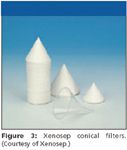
Figure 3
Chromatography and Sample Preparation Accessories
Table III lists 34 new hardware products and accessories for HPLC, GC, capillary electrophoresis (CE), and sample preparation. This year, I have extended the columns and sample preparation accessories to include dedicated instruments that are designated to automate some of the sample preparation techniques reported in Table II. All of the products introduced were practical devices designed to make the chromatographer's life easier. I will cover each area individually.
HPLC, LC–MS, and ion chromatography products: With the use of increased pressure in ultrahigh-pressure liquid chromatography (UHPLC), devices have sprung up to be compatible with the high pressures or for the ultraclean system needs to prevent clogging of low porosity frits and narrow connecting lines. For example, for pressures up to 20,000 psi, Optimize Technologies introduced a precolumn filter with 0.2-μm porosity with a built-in depth filter and Valco showed high-pressure fittings with special ferrules and nuts that will tightly hold fused-silica, PEEK, or other tubing used for columns and connectors. Supelco introduced high performance finger-tight fittings and connecting tubing with special sealing designed to work at 15,000 psi. Millipore introduced UHPLC sample preparation devices such as syringe filters and ultrapure water systems (Table II). Guard columns capable of 12,000-psi operation that were prepacked with sub-2-μm packing also were introduced.
It has become quite fashionable to use higher temperatures in HPLC. High temperature lowers pressure, provides better efficiency, and decreases retention. Product introductions for higher temperature operation included a new oven that accommodates both analytical and preparative columns and sleeve heaters that can slip over small columns and mobile phase lines to prevent thermal mismatch of solvents.
GC products: With the world's supply of helium dwindling and becoming more expensive, users are looking for other carrier gas sources that can provide an inexpensive, safe, pure, and plentiful gas supply. Hydrogen gas has superior properties to helium in terms of diffusivity and viscosity but users often are concerned about having additional cylinders of hydrogen around the laboratory. Hydrogen generators can provide carrier gas without fear of safety because only a few tens of milliliters are actually present at any given time. Nitrogen and zero air generators also provide a source of pure gas needed for chromatography and MS applications. Gas purifiers ensure that the quality of carrier gas that makes it to the instrument is as pure as any source of gas can be. Gas flow meters are available to check on the reproducible delivery of the gases. Table III shows a number of gas generator systems and other components that were introduced at Pittcon 2008.
Figure 4 shows another convenience product that should be of interest to gas chromatographers who must change columns on the run, the Cool-Lock Nut developed by Phenomenex (Torrance, California). This product was designed with an outer low-thermal-mass knurled installation wheel and an inner second securing nut. It allows a column to be changed before the oven has cooled because the knurled installation wheel cools down faster than a standard column nut. In addition, the second nut with a compression ferrule helps to hold the column at a constant length during installation.
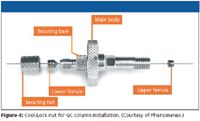
Figure 4
Sample Preparation Products: Table II shows that manufacturers are serious about providing certified and high quality accessories like vials, syringes, and GC glass inlet liners that have become quite vogue as automation users desire to ensure that these consumables are of high purity and inert for trace analysis and have tight specifications for automated sample handling and autosampler systems. Autosampler innovations also were present at Pittcon 2008. Thermal extraction, automated weighing stations, automated liner exchange, and dynamic headspace were some of the features added to autosamplers to provide levels of automation physically close to the instrument.
Devices such as homogenizers, evaporators, concentrators, and vortexers are designed to take away some of the drudgery of sample preparation. Such products always are found on the Pittcon floor, and I list some of those shown this year with improved features over previous models.
Acknowledgment
I would like to thank the manufacturers and distributors that kindly furnished the requested information in advance of Pittcon 2008, thus, allowing a timely report on new product introductions. For those manufacturers who would like to be considered for inclusion into Pittcon '09 coverage, please send the name of the primary company contact, the mailing address, FAX and E-mail numbers to Patrick Kempf, Editor, LC/GC North America, c/o Advanstar Communications, 485 Rte. 1 South, Bldg. F, Iselin, NJ 08830,
Attn.: Pittcon '08 "Column Watch."
Ronald E. Majors "Sample Prep Perspectives" Editor Ronald E. Majors is business development manager, Consumables and Accessories Business Unit, Agilent Technologies, Wilmington, Delaware, and is a member of LCGC's editorial advisory board. Direct correspondence about this column to "Sample Prep Perspectives," LCGC, Woodbridge Corporate Plaza, 485 Route 1 South, Building F, First Floor, Iselin, NJ 08830, e-mail lcgcedit@lcgcmag.com
References
(1) R.E. Majors, LCGC 25(3), 248–266 (2007).
(2) R.E. Majors, LCGC 25(4), 340–358 (2007).
(3) N. Zolotarjova, P. Mronzinski, and R.E. Majors, LCGC 25(2), 118–140 (2007).
(4) S.J. Lehotay, K. Mastovska, and A.R. Lightfield, JAOAC Int., 88(2, Mar-Apr):615–629 (2005).
(5) S.J. Lehotay, Proc, AOAC Annual Meeting, St. Louis, Missouri (2004).
(6) M. Annastassiades, QuEChERS — A Mini-Multiresidue Method for the Analysis of Pesticide Residues in Low-Fat Products, www.quechers.com/.
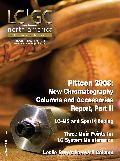
Silvia Radenkovic on Building Connections in the Scientific Community
April 11th 2025In the second part of our conversation with Silvia Radenkovic, she shares insights into her involvement in scientific organizations and offers advice for young scientists looking to engage more in scientific organizations.
Regulatory Deadlines and Supply Chain Challenges Take Center Stage in Nitrosamine Discussion
April 10th 2025During an LCGC International peer exchange, Aloka Srinivasan, Mayank Bhanti, and Amber Burch discussed the regulatory deadlines and supply chain challenges that come with nitrosamine analysis.
Polysorbate Quantification and Degradation Analysis via LC and Charged Aerosol Detection
April 9th 2025Scientists from ThermoFisher Scientific published a review article in the Journal of Chromatography A that provided an overview of HPLC analysis using charged aerosol detection can help with polysorbate quantification.












